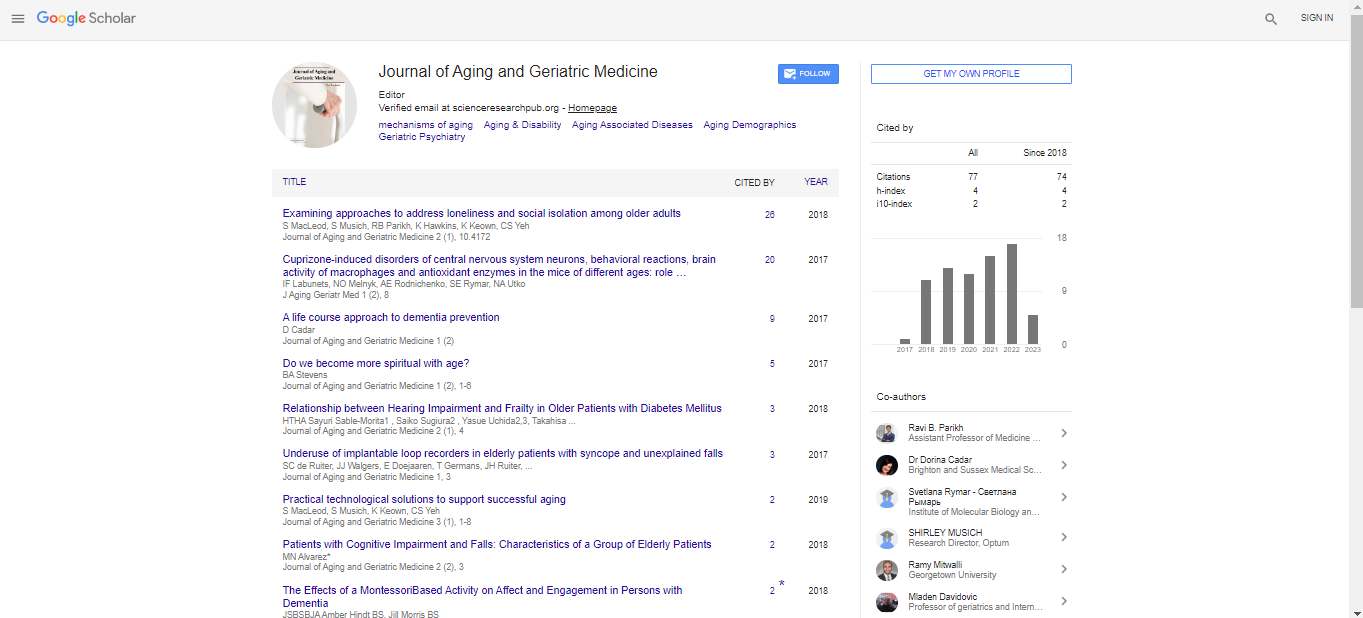Perspective, J Aging Geriatr Med Vol: 7 Issue: 4
Radiological Approaches in Enhancing Geriatric Healthcare through Imaging Modalities
Tezer Parham*
1Department of Emergency Medicine, McGill University Health Centre, Montreal, Canada
*Corresponding Author: Tezer Parham,
Department of Emergency Medicine,
McGill University Health Centre, Montreal, Canada
E-mail: perham.tez@mcgill.ca
Received date: 28 June, 2023, Manuscript No. AGM-23-113049;
Editor assigned date: 30 June, 2023, PreQC No. AGM-23-113049 (PQ);
Reviewed date: 14 July, 2023, QC No. AGM-23-113049;
Revised date: 21 July, 2023, Manuscript No. AGM-23-113049 (R);
Published date: 28 July, 2023, DOI: 10.4172/2576-3946.1000168
Citation: Parham T (2023) Radiological Approaches in Enhancing Geriatric Healthcare through Imaging Modalities. J Aging Geriatr Med 7:4.
Description
Aging is accompanied by various structural and functional changes in the body, leading to increased susceptibility to diseases and altered responses to interventions. The elderly population often presents with complex health conditions that require a comprehensive and tailored approach. The geriatric population presents unique challenges in the field of radiology due to age-related physiological changes and the prevalence of age-associated diseases. Radiological imaging plays a crucial role in diagnosing, monitoring, and managing geriatric conditions, helping to tailor personalized care plans for older individuals.
Age-related changes and imaging modalities
Bone density and osteoporosis: Dual-energy X-ray Absorptiometry (DXA) is the gold standard for assessing bone mineral density. Early detection of osteoporosis facilitates timely interventions to prevent fractures. CT and MRI are used to evaluate muscle mass and composition. Sarcopenia, the loss of muscle mass and strength, can be quantified through radiological assessments. Ultrasound, CT angiography, and Magnetic Resonance Angiography (MRA) visualize vascular changes.
Polypharmacy and medication-related effects: Radiology aids in assessing musculoskeletal health and identifying fractures resulting from falls, which are common concerns in the elderly. X-rays and CT scans are crucial for fracture detection and evaluation. Certain medications, such as bisphosphonates, may lead to atypical femoral fractures. Radiology helps diagnose and monitor these effects.
Cognitive decline and neuroimaging: Age-related brain atrophy can be assessed using structural MRI. Hippocampal volume reduction is linked to cognitive decline and Alzheimer's disease. Functional MRI (fMRI) studies reveal changes in brain activation patterns associated with cognitive decline and neurodegenerative disorders. Radiologists must be aware of geriatric-specific pathologies like colonic diverticulosis and degenerative joint disease when interpreting images.
Geriatric patients often present with multiple coexisting conditions, necessitating careful interpretation of imaging findings.
Role of radiology in geriatric medicine and palliative care
Radiological assessments aid in early disease detection, enabling timely interventions to prevent or manage age-related conditions. Imaging guides treatment decisions and monitors the effectiveness of interventions such as joint replacements, vascular procedures, and cancer treatments. Radiology contributes to personalized care plans by considering individual health status, comorbidities, and treatment goals. It assists in identifying sources of pain, such as vertebral compression fractures, and guides interventions like vertebroplasty. Serial imaging tracks disease progression, enabling timely adjustments in palliative care plans and treatment goals.
Future directions and technological advancements
Advancements in imaging technology, such as Artificial Intelligence (AI) and machine learning, hold potential for improving diagnostic accuracy and streamlining radiological workflows for geriatric patients. AI algorithms can aid in automated detection of abnormalities and quantitative assessment of age-related changes. Challenges include ensuring accessibility of imaging services for older adults, managing imaging-related risks, and addressing limitations due to patient comorbidities. Distinguishing age-related changes from pathological findings can be challenging. Radiologists must consider the clinical context to make accurate diagnoses. Older adults may have reduced renal function, increasing the risk of contrast-induced nephropathy. Choosing appropriate imaging modalities and contrast agents is essential. Involving geriatric patients and their caregivers in discussions about imaging procedures and potential risks is crucial for informed decision-making. Radiology plays a role in shared decisionmaking, allowing patients to understand the implications of imaging findings and choose treatments aligned with their values and preferences.
 Spanish
Spanish  Chinese
Chinese  Russian
Russian  German
German  French
French  Japanese
Japanese  Portuguese
Portuguese  Hindi
Hindi 